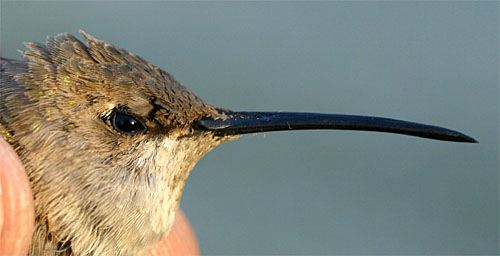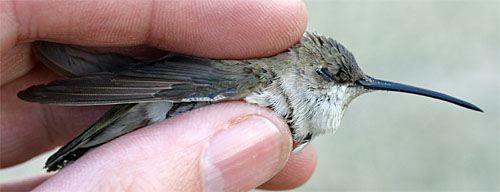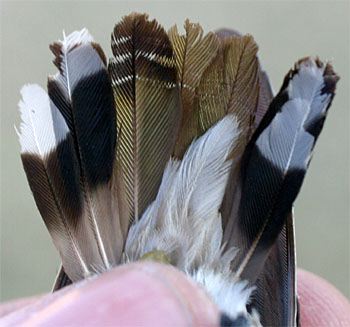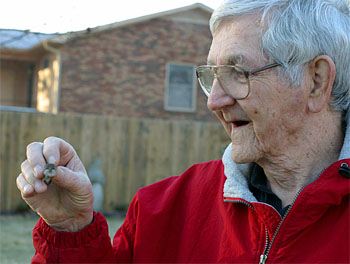|
|
|||
|
All text & photos © Hilton Pond Center On 24 January, Derrell Medlock posted a note to the Guestbook for our Hilton Pond Center Web site, stating that he had a female hummingbird coming to his feeder at Gastonia (Gaston County) NC, and wondering if we'd be interested in banding it. We immediately E-mailed Derrell about our desire to visit and said we could make the short 20-mile trip up US 321 from York two days later. Due to a glitch with his computer, we didn't hear from Derrell right away--which didn't matter because a week-long ice event struck the South Carolina Piedmont on the night of 25 January and made it impossible to travel. We next heard from Derrell on 10 February with a promising report that the bird was still present, so we immediately laid plans for the northward excursion on 13 February.
We arrived at the Medlock residence right at 7 a.m. on Friday the 13th and noted the skies were clear. Temperatures in the upper 20s meant surfaces that had been soaked by rain on two days preceding were quite slick, so while driving and walking we were careful to watch out for that dangerous winter phenomenon known as "black ice." Derrell's feeder, however, was toasty warm; he had rigged a heat lamp near it to keep the sugar water from freezing on cold days and nights. His solitary hummer had been coming regularly since mid-October 2003--about the same time three of his late Ruby-throated Hummingbirds departed for the tropics. Derrell suspected the remaining bird was also a ruby-throat, which away from the coastal regions would have been quite unusual in winter.
Following our usual procedure, we moved Derrell's feeder inside our portable hummingbird trap and began to hang the apparatus outside the kitchen window. Before we could finish, we were buzzed at 7:04 a.m. by a hummer that undoubtedly was making its first visit of the morning, so we completed our work and rushed inside the house. Within a minute or two the bird returned and then disappeared, only to come back at 7:09 a.m. and enter the feeder without hesitation. With a quick flick of our trigger finger, we tripped the switch on our battery-powered transmitter, thus sending signals to a little servo motor on the trap that caused a sliding door to shut behind the hummingbird. As we went back outside to retrieve the hummer, we were immediately struck by two curious revelations: 1) there was absolutely no rust color at the base of the bird's tail, and 2) its bill was quite long and noticeably decurved (top photo, and below). Since all but one of our captures this winter have been Rufous Hummingbirds with rusty tails, we were excited to see that this bird had to be something else, and we were intrigued further by the bill shape--especially since ruby-throats tend to have straight bills.
In Derrell's defense, his hummingbird--with green back and white breast and throat--did look a lot like a female ruby-throat, but other female hummers also have those characteristics. Our only way to know for sure what we had just captured was to take a complete set of measurements and to examine the bird's plumage.
Black-chinned Hummingbirds breed in the western U.S. with essentially no overlap on the nesting range of the ruby-throat. Black-chins typically overwinter in a very small area of south western Mexico but have been known to show up in the eastern U.S.--particularly in late winter. Adult males have a velvety black throat whose bottom edge is dark purple. (See photos and distribution map at the Web site for Operation RubyThroat: The Hummingbird Project.) Females of the two species look alike, however, hence the need to take measurements in-the-hand. Free-flying black-chins tend to bob their tails repeatedly when hovering, a characteristic that often can be used to identify females in the field.
Derrell Medlock's Black-chinned Hummingbird was the first we had banded in North Carolina and only the second report for the Tarheel State in the winter of 2003-04 (through 13 Feb). One was banded in Washington DC in November, and multiple bandings have occurred in all the Gulf Coast states. Derrell's bird showed quite bit of wear in its wing and tail feathers (above and above left). Based upon the rough nature of its plumage, it was obviously a second-year bird that hatched out sometime in 2003. Of particular interest were "fault bars" in several tail feathers--weak places perpendicular to the central shaft. These occurred when the bird was a nestling and were possibly the result of cold weather or insufficient food--factors that can keep feathers from developing properly.
Vital Statistics for All text & photos © Hilton Pond Center
If you're interested in sharing your hummingbird observations and learning from other enthusiasts, you may wish to subscribe to Hummingbird Hobnob, our Yahoo!-based discussion group. Also be sure to visit our award-winning Web site for Operation RubyThroat: The Hummingbird Project; on it you'll find almost anything you want to know about hummingbirds, including more information about Hummingbird Banding.
For much more information about hummingbirds, visit: |
|
Make direct donations on-line through
Network for Good: |
|
|
LIKE TO SHOP ON-LINE?
Donate a portion of your purchase price from 500+ top on-line stores via iGive: |
|
|
Use your PayPal account
to make direct donations: |
|
|
Back to Vagrant & Winter Hummingbird Banding Back to This Week at Hilton Pond Back to What's New? Current Weather Conditions at Hilton Pond Center |
 post questions for The Piedmont Naturalist |
Join the |
Search Engine for |
|
|





 Having carefully removed the bird from the trap--and with the blessings of Derrell's wife Jane--we went inside and set up our gear on the dining room table. Using an electronic balance, we determined the bird weighed 3.2 grams--a bit light compared to Rufous Hummingbirds we'd been handling. The bird's wing chord was quite long at 45.8mm, but the clincher was its 20.5mm bill. These measurements--plus the shape of the tail and outermost wing feathers--all led us to conclude that the bird in hand was a Black-chinned Hummingbird, Archilochus alexandri, the western counterpart of our far more common Ruby-throated Hummingbird, A. colubris. Derrell's bird was especially eventful for us because it was only the second black-chin we had ever banded.
Having carefully removed the bird from the trap--and with the blessings of Derrell's wife Jane--we went inside and set up our gear on the dining room table. Using an electronic balance, we determined the bird weighed 3.2 grams--a bit light compared to Rufous Hummingbirds we'd been handling. The bird's wing chord was quite long at 45.8mm, but the clincher was its 20.5mm bill. These measurements--plus the shape of the tail and outermost wing feathers--all led us to conclude that the bird in hand was a Black-chinned Hummingbird, Archilochus alexandri, the western counterpart of our far more common Ruby-throated Hummingbird, A. colubris. Derrell's bird was especially eventful for us because it was only the second black-chin we had ever banded.
 As we finished photographing this unusual Gastonia hummingbird, we gave it a final hit of sugar water and handed it to Derrell for release--paying no attention to his bright red jacket. It wasn't until we went back inside and started talking with Derrell and Jane Medlock that we realized the jacket was inscribed with the words "Newberry College," from which the two of them had graduated 'way back in 1950. This was of particular interest because Newberry is OUR undergraduate alma mater, too, and we were all surprised and enthralled that the happenstance of an overwintering Black-chinned Hummingbird had brought us together for a mini-reunion in Gastonia NC on this particular Friday the 13th. Hail Scarlet and the Gray!
As we finished photographing this unusual Gastonia hummingbird, we gave it a final hit of sugar water and handed it to Derrell for release--paying no attention to his bright red jacket. It wasn't until we went back inside and started talking with Derrell and Jane Medlock that we realized the jacket was inscribed with the words "Newberry College," from which the two of them had graduated 'way back in 1950. This was of particular interest because Newberry is OUR undergraduate alma mater, too, and we were all surprised and enthralled that the happenstance of an overwintering Black-chinned Hummingbird had brought us together for a mini-reunion in Gastonia NC on this particular Friday the 13th. Hail Scarlet and the Gray!

 Students at GLOBE-certified schools may submit winter hummingbird observations as part of Operation RubyThroat and GLOBE. Students can also correlate hummingbird observations with data on abiotic factors, including atmosphere, climate, hydrology, soils, land cover, and phenology. See the
Students at GLOBE-certified schools may submit winter hummingbird observations as part of Operation RubyThroat and GLOBE. Students can also correlate hummingbird observations with data on abiotic factors, including atmosphere, climate, hydrology, soils, land cover, and phenology. See the 


